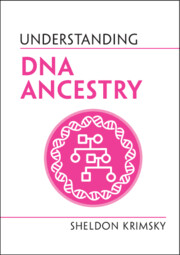Book contents
- Understanding DNA Ancestry
- Series page
- Understanding DNA Ancestry
- Copyright page
- Reviews
- Dedication
- Contents
- Foreword
- Acknowledgments
- 1 Introduction
- 2 The Business of DNA Ancestry
- 3 What Our Genomes Tell Us about the Geographical Origins and Movements of Early Human Populations
- 4 The Science behind DNA Ancestry Testing
- 5 Ancestry Informative Markers
- 6 Ancestry DNA Population Reference Panels
- 7 Comparing a Donor’s DNA to Reference Panel Populations
- 8 Probing Your DNA
- 9 Forensic Applications of Ancestry DNA Results
- 10 Privacy, Personal Identity, and Legal Issues
- 11 Discovering Unknown, Missing, or Mistaken Relatives
- 12 Accuracy, Consistency, and Validation of DNA Ancestry Tests
- 13 Conclusion
- Summary of Common Misunderstandings
- References
- Index
- Other books authored, coauthored, or coedited by Sheldon Krimsky
- References
References
Published online by Cambridge University Press: 05 March 2022
- Understanding DNA Ancestry
- Series page
- Understanding DNA Ancestry
- Copyright page
- Reviews
- Dedication
- Contents
- Foreword
- Acknowledgments
- 1 Introduction
- 2 The Business of DNA Ancestry
- 3 What Our Genomes Tell Us about the Geographical Origins and Movements of Early Human Populations
- 4 The Science behind DNA Ancestry Testing
- 5 Ancestry Informative Markers
- 6 Ancestry DNA Population Reference Panels
- 7 Comparing a Donor’s DNA to Reference Panel Populations
- 8 Probing Your DNA
- 9 Forensic Applications of Ancestry DNA Results
- 10 Privacy, Personal Identity, and Legal Issues
- 11 Discovering Unknown, Missing, or Mistaken Relatives
- 12 Accuracy, Consistency, and Validation of DNA Ancestry Tests
- 13 Conclusion
- Summary of Common Misunderstandings
- References
- Index
- Other books authored, coauthored, or coedited by Sheldon Krimsky
- References
- Type
- Chapter
- Information
- Understanding DNA Ancestry , pp. 131 - 145Publisher: Cambridge University PressPrint publication year: 2021



